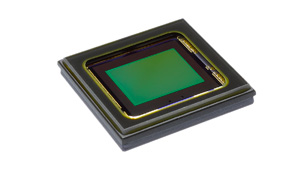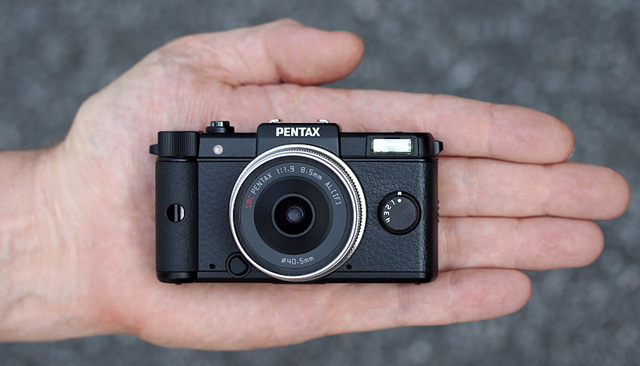
Pentax announced on Thursday that it plans to release an entirely new compact interchangeable lens digital camera even smaller than the current crop of mirrorless Micro Four Thirds system cameras from the likes of Olympus and Panasonic. Dubbed the Pentax Q, the camera is built around a 1/2.33" image sensor more commonly found in compact point-and-shoot cameras. This allows for a tiny form factor and even smaller lenses, though it comes with an image quality compromise that might turn off shooters that would ostensibly appreciate the benefits of interchangeable lenses.
The Pentax Q camera is slightly larger than a credit card in size and just under an inch and a quarter thick (3.9 x 2.3 x 1.2", to be exact). That is comparable to many compact digital cameras available today. Our friends at Imaging Resource gained access to a pre-production sample and took a few photos to illustrate just how small it really is.
Unlike most compact digital cameras, however, the Pentax Q has a tiny bayonet mount which accepts new Q-mount Pentax lenses. The camera is expected to hit the US in September, and at launch there will be five different lenses available. A compact 8.5mm f/1.9 standard prime lens—approximately 47mm equivalent with a 5.5x crop factor—will be sold with the camera as a kit. Pentax will also offer a 5-15mm zoom lens (28-80mm equiv.), a fisheye lens, and wide angle (35mm equiv.) and telephoto (100mm equiv.) "toy" lenses that mimic the vignetting and variable sharpness of classic Holga or Diana plastic cameras. That particular style has been made extremely popular by the likes of Instagram, Hipstamatic, and Camera Bag on iOS devices.

At the heart of the camera is a 12 megapixel, backside illuminated Sony CMOS sensor. Its tiny 1/2.33" size means tiny, noisy pixels, but Pentax spokesperson Chris Pound told Ars that the backside illumination should compensate for the small sensor size. In fact, Imaging Resource told Ars that images from its pre-production sample compare favorably to the Canon G12 even at high ISO settings. That's high praise for such a tiny camera—the sensor in the G12 is larger and has 2 million fewer pixels, so backside illumination clearly offers a major advantage.
Pentax could have used a larger sensor for better performance still, but that would have resulted in a larger camera and larger lenses. "The 1/2.33" sensor allowed us to achieve our goal of building the world's smallest and lightest interchangeable lens camera," Pound explained. "Using an existing mount would have resulted in concessions on size, which we didn't want for the Q."

The sensor also includes an anti-shake mounting that provides image stabilization functions as well as the ability to shake loose dust that gets inside the camera.
The Pentax Q is built using a lightweight, durable magnesium alloy. It also features a 460K pixel 3" rear LCD display for framing and viewing images. And it includes many of the common automatic and manual exposure modes found on higher end compacts and DSLRs. Some interesting built-in functions include a bokeh control and in-camera HDR shooting. Like most digital cameras, it also has the ability to shoot digital video at 1080p HD resolution. And the camera can be configured to shoot in 4:3, 3:2, 16:9, and square aspect ratios.
As a photographic tool, the Q certainly covers a lot of bases, and its tiny size is simply incomparable to any other interchangeable lens camera available. While its interchangeable lens system might appeal to more demanding shooters that lament the sorry state of digicam zooms, though, the image quality from its tiny sensor might not satisfy those same shooters. "Put the Q's images next to those from even a Micro Four Thirds camera, and the larger sensor wins hands down," Imaging Resource's Dave Etchells told Ars.

The sheer novelty of the Pentax will likely attract some buyers, but an honest evaluation of the final shipping product will show whether the image quality is worth the price and the added hassle of carrying additional lenses. Ultimately we're left with an impression of a digital version of Pentax's 110 SLR of the early 80s—an excellent camera that made the best of the limitations of 110 films tiny format, but never quite became a resounding commercial success. Still, the gadget geek in us is definitely piqued.
reader comments
50